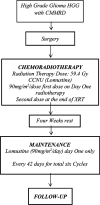Pakistan National Guidelines for Pediatric High-Grade Gliomas
- PMID: 37680835
- PMCID: PMC10480739
- DOI: 10.12669/pjms.39.5.6300
Pakistan National Guidelines for Pediatric High-Grade Gliomas
Abstract
Pediatric high-grade glioma (pHGG) is highly malignant central nervous system tumor and constitute 10% of the pediatric gliomas. Effective treatment needs a functioning multi-disciplinary team including pediatric neuro oncologist, neurosurgeon, neuroradiologist, neuropathologist and radiation oncologist. Despite surgical resection, radiotherapy and chemotherapy, most HGG will recur resulting in early death. A significant proportion of HGG occurs in context of cancer predisposition syndromes like Constitutional Mismatch Repair Deficiency (CMMRD) also known as Biallelic Mismatch Repair Deficiency (bMMRD) characterized by high mutational burden. The incidence of HGG with CMMRD is one per million patients. bMMRD is caused by homozygous germline mutations in one of the four Mis Match Repair (MMR) genes (PMS2, MLH1, MSH2, and MSH6). The use of TMZ is now avoided in CMMRD related HGG due to its limited response and known ability to increase the accumulation of somatic mutations in these patients, increasing the risk of secondary tumors. HGG should be managed under the care of multidisciplinary team to receive optimum treatment. This is particularly important for low middle-income countries (LMIC) with limited resources like Pakistan.
Keywords: Central Nervous System Tumor; Germline Mutation; Guidelines; Mismatch Repair Genes PMS2; Temozolomide.
Copyright: © Pakistan Journal of Medical Sciences.
Conflict of interest statement
Conflict of interest: None.
References
-
- Pollack IF, Hamilton RL, Sobol RW, Burnham J, Yates AJ, Holmes EJ, et al. O6-methylguanine-DNA methyltransferase expression strongly correlates with outcome in childhood malignant gliomas:Result from the CCG-945 Cohort. J Clin Oncol. 2006;24(21):3431–3437. doi: 10.1200/JCO.2006.05.7265. - PubMed
-
- Finley JL, Boyett JM, Yates AJ, Wisoff JH, Milstein JM, Geyer JR, et al. Randomized phase III trial in childhood high-grade astrocytoma comparing vincristine, lomustine and prednisolone with eight-in-1-day regime. Childrens Cancer Group. J Clin Oncol. 1995;13(1):112–123. doi: 10.1200/JCO.1995.13.1.112. - PubMed
-
- Stupp R, Mason WP, Van Den Bent MJ, Weller M, Fisher B, Taphoorn MJ, et al. Radiotherapy plus concomitant and adjuvant temozolomide for glioblastoma. N Engl J Med. 2005;352(10):987–996. doi: 10.1056/NEJMoa043330. - PubMed
-
- Sposto R, Ertel IJ, Jenkin RD, Boesel CP, Venes JL, Ortega JA, et al. The effectiveness of chemotherapy for treatment of high grade astrocytoma in children:results of a randomized trial. A report from the Childrens Cancer Study Group. J Neurooncol. 1989;7(2):165–177. doi: 10.1007/BF00165101. - PubMed
LinkOut - more resources
Full Text Sources
Miscellaneous


